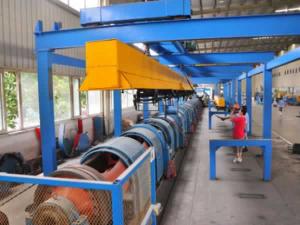
- Home
- Products
- Wire Drawing Machines
- Straight Line Steel Wire Drawing Machine
Straight Line Steel Wire Drawing Machine
Description
The straight line steel wire drawing machine is a heavy duty wire drawing machine, engineered for the drawing of high strength, high performance steel wire. This drawing equipment is suitable for bead wire, rope making wire, stainless steel wire, alloy wire, etc.
Our steel drawing machinery has a whole list of functions including an advanced user interface and a highly reliable motor overheating protection device.
Technical Process
Pay-off → Shell cleaning (pre-processing)→ Wire rod pointing → (Buttering) → Drawing wire → Take-up (spool or trunk take-up).

Main Characteristics
Reliability: Field bus technology is used for the electrical control system for stable and reliable operation.
Energy saving
It adopts an AC frequency regulator dragging which can reduce impact caused by the motor starting.
High efficiency: The straight line steel wire drawing machine greatly reduces the failure rate of the products
| Type | 300 | 350 | 400 | 450 | 500 | 560 | 600 | 700 | 800 |
| Inlet wire strength (mpa) | ≤1250 | ||||||||
| Drawing Passes | 2-11 | 2-11 | 2-11 | 2-12 | 2-12 | 2-12 | 2-12 | 2.9 | 2.9 |
| Max inlet diameter (mm) | 2.8 | 3.5 | 4.2 | 5.0 | 5.5 | 6.5 | 8 | 10 | 12.7 |
| Min inlet diameter (mm) | 0.5 | 0.6 | 0.75 | 1.0 | 1.2 | 1.1 | 1.6 | 2.2 | 2.6 |
| Max speed (m/s) | -25 | -20 | -20 | -16 | -15 | -15 | -12 | -12 | -8 |
| Power (KW) | 7.5-18.5 | 11-22 | 11-30 | 15-37 | 22-45 | 22-55 | 30-75 | 45-90 | 55-110 |
| Drawing materials | Steel wire(high, medium, low carbon wire, stainless steel wire, prestressed wire, bead wire, rubber tube wire, spring steel wire, steel cord steel wire etc.) welding wire(gas shielded welding wire, submerged arc welding wires, flux-cored wire etc.) alloy wire etc. | ||||||||
A Straight Line Steel Wire Drawing Machine is a type of industrial equipment used to pull or draw steel wire through a series of dies in order to reduce its diameter, while increasing its length. The machine consists of a motor that drives a series of capstans, which grip the wire and pull it through a die. The die reduces the wire's diameter, and the process is repeated through a series of progressively smaller dies until the desired diameter is achieved. The resulting wire is often used in applications such as construction, automotive manufacturing, and electrical wiring.





